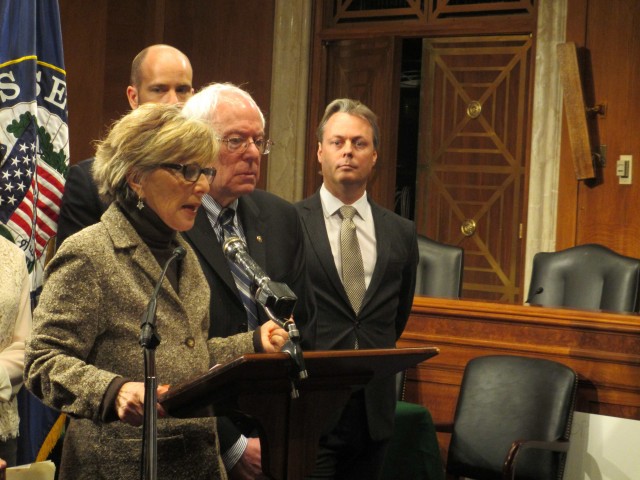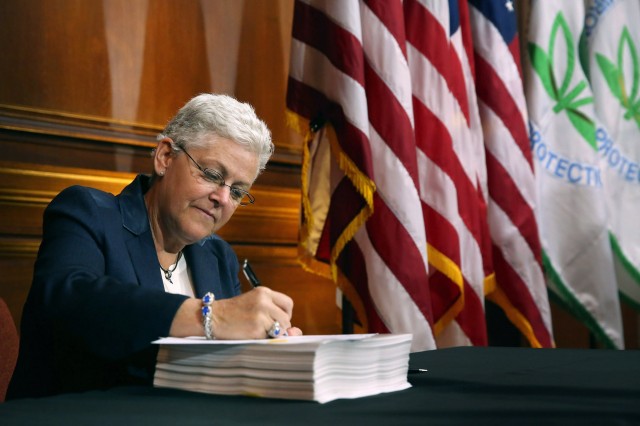On Monday, the Environmental Protection Agency proposed new regulations to cut carbon pollution from the nation’s power plants 30 percent from 2005 levels by 2030. Under the Clean Power Plan, states will choose their own paths to meet the emissions goals. They can work alone to develop individual plans or collaborate with other states. State plans are not due until June 2016, and states can use a two-step process to submit their final plans later if more time is needed.
It is expected that many states will implement cap-and-trade policies to comply with the EPA Clean Power Plan. Under cap and trade, companies must purchase permits from the government that allow them to emit set levels of greenhouse gases. There is a set number of permits, and the costs of the permits rise as the number of permits issued drops. The policy is meant to create financial incentive for industries to reduce emissions and increase efficiency. A cap-and-trade program that launched in California last year has so far been successful at raising the price of carbon, to over $11 per ton, 60 percent above the European price, and higher than that in any cap and trade market.
Europe has had many problems with cap and trade since its implementation in 2006. These failures largely resulted from preliminary dishonest emission rates reporting by fossil fuel corporations, and the lack of a mechanism to prevent the extreme dip in carbon prices that accompanied the 2008 and 2009 financial crises. The European system hasn’t significantly increased the price of carbon or lowered emissions, and what carbon price increase has occurred has been largely felt by consumers at the pump, not reflected in reformed industry practices. In addition, the market for carbon offsets, which industries can purchase to offset their carbon emissions, has been beleaguered by offsets that don’t fully recover the amount of released carbon.
In America, the biggest failure of cap and trade has been for it to gain enough political momentum for any overarching policy. Even if a policy was widely adopted and aggressive enough to allow for a significant increase in the price of carbon, climate scientists like James Hansen, and politicians like former Republican senator Bob Inglis still question the effectiveness of cap and trade as a climate change solution. Problems include inadequate carbon offsets, fluctuations in carbon prices, false reporting by corporations, opportunities for the government to give away permits, the burden on consumers, and the fact that cap and trade is a complicated, bureaucratic system. According to James Hansen, “cap and trade increases the cost of energy for the public, as utilities and other industries purchase the right to pollute with one hand, adding it to fuel prices, while with the other hand they take back most of the permit revenues from the government.” He points out that the costs of the trading infrastructure must also be paid by the public. In addition the “cap” of cap and trade ensures a certain level of pollution. Hansen explains that “if every polluter’s emissions fell below the incrementally lowered cap, then the price of pollution credits would collapse and the economic rationale to keep reducing pollution would disappear.” An alternative to cap and trade, long favored by James Hansen, which Senators Barbara Boxer (D-Calif) and Bernie Sanders (I-VT) proposed in the Climate Protection Act of 2013, is called “fee and dividend.”
Fee and dividend, like cap and trade, creates an effective tax on carbon. The fee is based on the tons of carbon dioxide the fuel would generate, and is collected at the earliest point of entry into the economy, not at the pump like in cap and trade. Then, instead of that fee going back to the government, like a true tax, it is paid to citizens as a dividend. Boxer and Sanders’s bill proposed that three-fifths of the dividend would be paid directly to the American citizen, to help the citizen recover from increased energy costs, and two-fifths back to the government for investments in renewable energy.

Fee and dividend has some advantages over cap and trade. Under fee and dividend, there are no carbon credits or offset credits to manipulate, and no carbon traders and offset investors who can work the market for profit. After several years, companies who do not adapt to use less carbon-heavy fossil fuels become disadvantaged, but this change is gradual, and allows the companies who take action to become more efficient and competitive. The free market selects the winning and losing technology along the lines of what is also best for the climate. As the cost of fossil fuels rise, low-emissions and carbon efficiency practices become economically competitive. In 2008, British Columbia implemented fee and dividend. Per capita consumption of petroleum fuels in the province dropped 17.4 percent, while national Canadian consumption of petroleum fuel grew by 1.5 percent in the same period.
The RSA Action and Research Centre Report, “A New Agenda on Climate Change,” is in favor of fee and dividend but admits that, “its simplicity breaks down when you are not dealing with domestic fossil fuel production but with imports.” In this case, the only option is to charge a fee to the fuel importer. If other countries are not also charging fees, this can threaten energy security. However, even if fee and dividend only influenced domestic production, it would have a tremendous result, as the U.S. currently produces and exports immense amounts of energy from coal and oil.
If a national cap-and-trade or fee-and-dividend policy is implemented, and carbon prices rise, this will be a victory, but many economists and climate change scientists believe that it is impossible to rely on existing financial markets to halt climate change. Kevin Anderson, the deputy director of the Tyndall Centre for Climate Change, calls instead for “a comprehensive and regulatory and standard-based framework.” Anderson points out that under any market scheme:
Professors, MPs, ministers, business leaders, GPs, barristers, etc. would all be able to absorb a significant proportion of any politically-acceptable carbon price. So we may buy a slightly more efficient 4WD/SUV, cut back a little on our frequent flying, consider having a smaller second home where we may even choose an A+ retro Smeg fridge- freezer (the A++ being a little too ‘modern’ looking) – but overall we’d carry on with our business as usual.This view suggests that the only real solution to climate change is to reform the behaviors of the upper class who will always be able to afford high-carbon lifestyles. This means convincing people to drive less, buy less, and fly less, before the unlikely efficient electric airplane, the unlikely advent of clean fuel, or the unlikely political reality that flights become too expensive for those with high incomes.
Anderson continues to point out that as the wealthier echelons continue to consume, the poorer members of society, who will also be hit hardest by climate change, will be hurt by higher fuel prices. Anderson imagines that they:
would have to cut back still further in heating their inadequately insulated and badly designed rented properties. Their children would perhaps begin to suffer more bronchial problems as their houses become colder and damper; so more trips to the doctor – but the increased price of road fuel makes this more expensive.This is a bleak portrait of a world in which carbon is expensive, and perhaps cynically ignores the possibility of renewable energy that would allow for home heating and travel that is no more expensive than it is currently. Anderson does highlight the reality that the technology isn’t yet there for our current levels of energy consumption to be supplied with renewable energy that is both efficient and affordable. Our energy demand must change too.
However, policies such as cap and trade, or the more straightforward fee and dividend, would encourage the innovation of clean energy. Any move on fossil fuel policy in the United States away from its reliance on carbon is positive, especially as it may signify and encourage the broad societal change that is so crucial today. States have the freedom to decide how to meet the new EPA carbon pollution standards. Cap and trade, fee and dividend, a flat carbon tax, investments in renewable energy, and behavioral shifts all have the same end goal: to keep carbon in the ground. Any policy that leads toward this goal is a good one.
